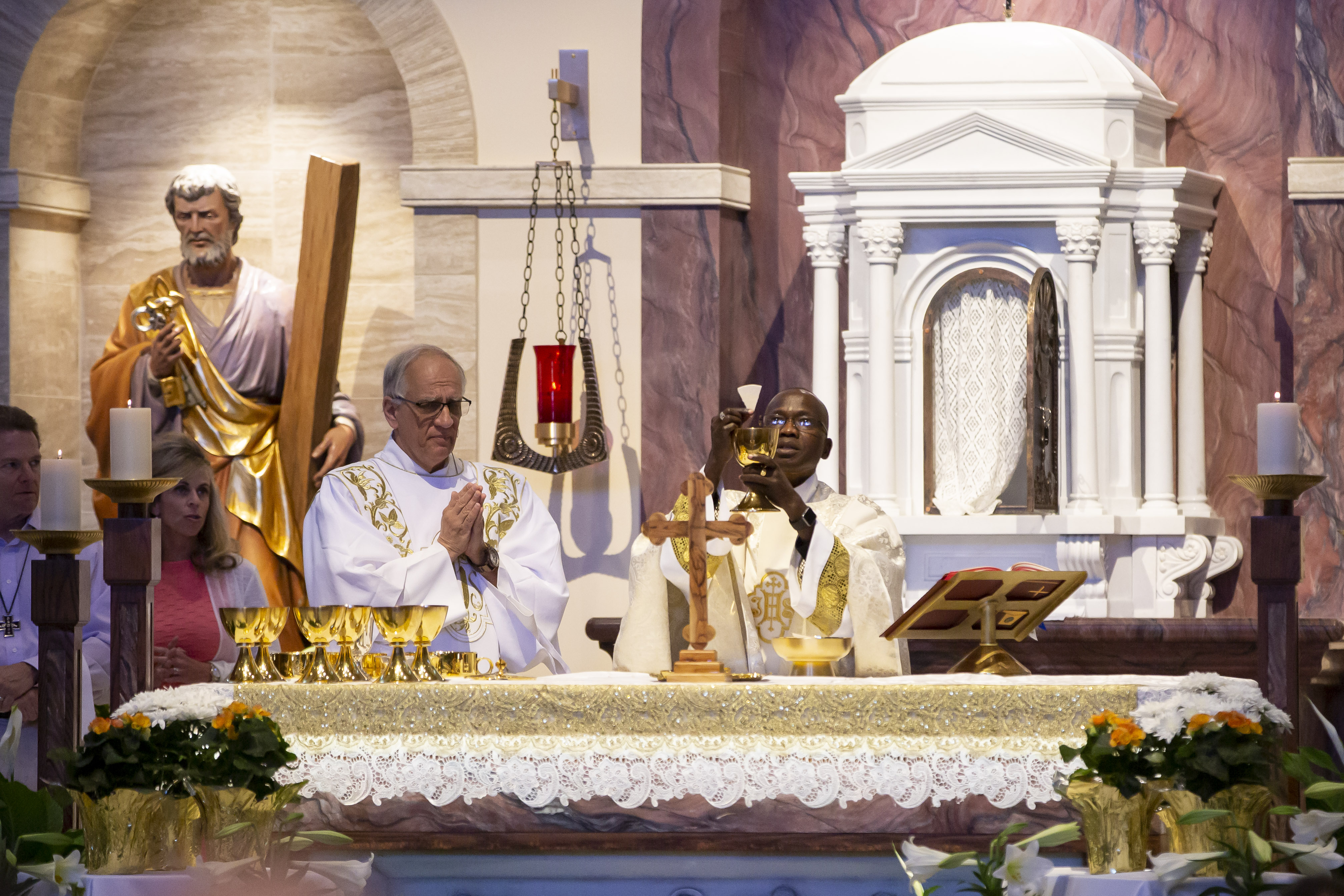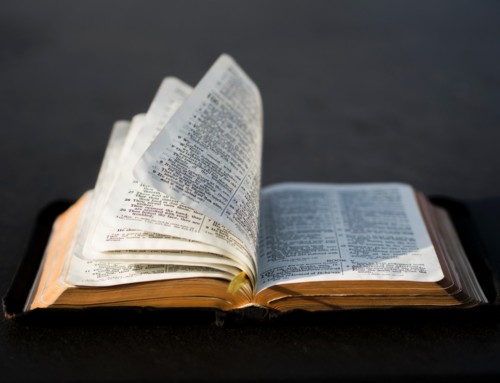THE MASS: Liturgy of the Eucharist
The Liturgy of the Eucharist begins with the preparation of the gifts and the altar. As the ministers prepare the altar, representatives of the people bring forward the bread and wine that will become the Body and Blood of Christ. The celebrant blesses and praises God for these gifts and places them on the altar, the place of the Eucharistic sacrifice. In addition to the bread and wine, monetary gifts for the support of the Church and the care of the poor may be brought forward. The Prayer over the Offerings concludes this preparation and disposes all for the Eucharistic Prayer.
Prayer for Life
The Eucharistic Prayer is the heart of the Liturgy of the Eucharist. In this prayer, the celebrant acts in the person of Christ as head of his body, the Church. He gathers not only the bread and the wine, but the substance of our lives and joins them to Christ’s perfect sacrifice, offering them to the Father.
The introductory dialogue, establishes that this prayer is the prayer of the baptized and ordained, is offered in the presence of God, and has thanksgiving as its central focus. Following this dialogue, the celebrant begins the Preface.
The Eucharistic Prayers make clear that these prayers are offered, not to Christ, but to the Father. It is worship offered to the Father by Christ as it was at the moment of his passion, death and resurrection, but now it is offered through the priest acting in the person of Christ, and it is offered as well by all of the baptized, who are part of Christ’s Body, the Church. This is the action of Christ’s Body, the Church at Mass.
The priest offers the Eucharistic Prayer in the first-person plural, for example, “Therefore, O Lord, we humbly implore you…” This “we” signifies that all the baptized present at the Eucharistic celebration make the sacrificial offering in union with Christ and pray the Eucharistic Prayer in union with him. And what is most important, we do not offer Christ alone; we are called to offer ourselves, our lives, our individual efforts to grow more like Christ and our efforts as a community of believers to spread God’s Word and to serve God’s people, to the Father in union with Christ through the hands of the priest. Most wonderful of all, although our offering is in itself imperfect, joined with the offering of Christ it becomes perfect praise and thanksgiving to the Father.
The General Instruction of the Roman Missal (no. 79) provides the following summary of the Eucharistic Prayer:
The main elements of which the Eucharistic Prayer consists may be distinguished from one another in this way:
a) The thanksgiving (expressed especially in the Preface), in which the Priest, in the name of the whole of the holy people, glorifies God the Father and gives thanks to him for the whole work of salvation or for some particular aspect of it, according to the varying day, festivity, or time of year.
b) The acclamation, by which the whole congregation, joining with the heavenly powers, sings the Sanctus (Holy, Holy, Holy). This acclamation, which constitutes part of the Eucharistic Prayer itself, is pronounced by all the people with the Priest.
c) The epiclesis, in which, by means of particular invocations, the Church implores the power of the Holy Spirit that the gifts offered by human hands be consecrated, that is, become Christ’s Body and Blood, and that the unblemished sacrificial Victim to be consumed in Communion may be for the salvation of those who will partake of it.
d) The Institution narrative and Consecration, by which, by means of the words and actions of Christ, that Sacrifice is effected which Christ himself instituted during the Last Supper, when he offered his Body and Blood under the species of bread and wine, gave them to the Apostles to eat and drink, and leaving with the latter the command to perpetuate this same mystery.
e) The anamnesis, by which the Church, fulfilling the command that she received from Christ the Lord through the Apostles, celebrates the memorial of Christ, recalling especially his blessed Passion, glorious Resurrection, and Ascension into heaven.
f) The oblation, by which, in this very memorial, the Church, in particular that gathered here and now, offers the unblemished sacrificial Victim in the Holy Spirit to the Father. The Church’s intention, indeed, is that the faithful not only offer this unblemished sacrificial Victim but also learn to offer their very selves,and so day by day to be brought, through the mediation of Christ, into unity with God and with each other, so that God may at last be all in all.
g) The intercessions, by which expression is given to the fact that the Eucharist is celebrated in communion with the whole Church, of both heaven and of earth, and that the oblation is made for her and for all her members, living and dead, who are called to participate in the redemption and salvation purchased by the Body and Blood of Christ.
h) The concluding doxology, by which the glorification of God is expressed, and which is affirmed and concluded by the people’s acclamation “Amen.”
Communion Rite
The Communion Rite follows the Eucharistic Prayer, leading the faithful to the Eucharistic table.
The rite begins with the Lord’s Prayer. Jesus taught this prayer to his disciples when they asked how to pray (cf. Mt 6:9-13, Lk 11:2-4). In this prayer, the people join their voices to pray for the coming of God’s kingdom and to ask God to provide for our needs, forgive our sins, and bring us to the joy of heaven.
The Rite of Peace follows. The celebrant prays that the peace of Christ will fill our hearts, our families, our Church, our communities, and our world. As a sign of hope, the people extend to those around them a sign of peace.
In the Fraction Rite, the celebrant breaks the consecrated bread as the people sing the Agnus Dei or “Lamb of God.” John the Baptist proclaimed Jesus as “the Lamb of God who takes away the sin of the world” (Jn 1:29). The action of breaking the bread recalls the actions of Jesus at the Last Supper, when he broke the bread before giving it to his disciples. One of the earliest names for the Eucharistic celebration is the breaking of the bread (Lk 24:35; Acts 2:42, 46).
Before receiving Holy Communion, the celebrant and assembly acknowledge their unworthiness to receive so great a gift. The celebrant receives Holy Communion first and then the people come forward.
Those who receive Holy Communion should be prepared to receive so great a gift. They should fast (except for medicines) for at least one hour before receiving the Eucharist and should not be conscious of having committed serious sin.
Because sharing at the Eucharistic Table is a sign of unity in the Body of Christ, only those in communion with the Catholic Church may receive Holy Communion. To invite others present to receive Holy Communion implies a unity which does not exist. Those who do not receive Holy Communion still participate in this rite by praying for unity with Christ and with each other.
The people approach the altar and, bowing with reverence, receive Holy Communion. People may receive the Body of Christ either on the tongue or in the hand. The priest or other minister offers the Eucharist to each person saying, “The Body of Christ.” The person receiving responds by saying, “Amen,” a Hebrew word meaning, “So be it” (Catechism of the Catholic
Church, 2856).
As the people receive Holy Communion, the communion chant/song is sung. The unity of voices echoes the unity the Eucharist brings. All may spend some time in silent prayer of thanksgiving as well.
The Communion Rite ends with the Prayer after Communion which asks that the benefits of the Eucharist will remain active in our daily lives.
Copyright © 2015 United States Conference of Catholic Bishops, Washington, D.C. Used with permission. All rights reserved.







